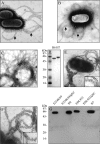Host protein binding and adhesive properties of H6 and H7 flagella of attaching and effacing Escherichia coli
- PMID: 17693516
- PMCID: PMC2168434
- DOI: 10.1128/JB.00464-07
Host protein binding and adhesive properties of H6 and H7 flagella of attaching and effacing Escherichia coli
Abstract
It had been suggested that the flagella of enteropathogenic Escherichia coli (EPEC) and enterohemorrhagic E. coli (EHEC) might contribute to host colonization. In this study, we set out to investigate the adhesive properties of H7 and H6 flagella. We studied the abilities of EHEC EDL933 (O157:H7) and EPEC E2348/69 (O127:H6) flagella to bind to bovine mucus, host proteins such as mucins, and extracellular matrix proteins. Through several approaches, we found that H6 and H7 flagella and their flagellin monomers bind to mucins I and II and to freshly isolated bovine mucus. A genetic approach showed that EHEC and EPEC fliC deletion mutants were significantly less adherent to bovine intestinal tissue than the parental wild-type strains. In addition, we found that EPEC bacteria and H6 flagella, but not EHEC, bound largely, in a dose-dependent manner, to collagen and to a lesser extent to laminin and fibronectin. We also report that EHEC O157:H7 strains agglutinate rabbit red blood cells via their flagella, a heretofore unknown phenotype in this pathogroup. Collectively, our data demonstrate that the H6 and H7 flagella possess adhesive properties, particularly the ability to bind mucins, that may contribute to colonization of mucosal surfaces.
Figures







Similar articles
-
Bacterial flagella: twist and stick, or dodge across the kingdoms.PLoS Pathog. 2015 Jan 15;11(1):e1004483. doi: 10.1371/journal.ppat.1004483. eCollection 2015 Jan. PLoS Pathog. 2015. PMID: 25590430 Free PMC article. Review.
-
Polymorphisms within EspA filaments of enteropathogenic and enterohemorrhagic Escherichia coli.Infect Immun. 2003 Apr;71(4):2262-5. doi: 10.1128/IAI.71.4.2262-2265.2003. Infect Immun. 2003. PMID: 12654853 Free PMC article.
-
An investigation of the expression and adhesin function of H7 flagella in the interaction of Escherichia coli O157 : H7 with bovine intestinal epithelium.Cell Microbiol. 2009 Jan;11(1):121-37. doi: 10.1111/j.1462-5822.2008.01244.x. Epub 2008 Oct 30. Cell Microbiol. 2009. PMID: 19016776
-
Enterohaemorrhagic Escherichia coli O157:H7 target Peyer's patches in humans and cause attaching/effacing lesions in both human and bovine intestine.Gut. 2000 Sep;47(3):377-81. doi: 10.1136/gut.47.3.377. Gut. 2000. PMID: 10940275 Free PMC article.
-
Interaction of Escherichia coli O157:H7 with leafy green produce.J Food Prot. 2009 Jul;72(7):1531-7. doi: 10.4315/0362-028x-72.7.1531. J Food Prot. 2009. PMID: 19681282
Cited by
-
Bacterial flagella: twist and stick, or dodge across the kingdoms.PLoS Pathog. 2015 Jan 15;11(1):e1004483. doi: 10.1371/journal.ppat.1004483. eCollection 2015 Jan. PLoS Pathog. 2015. PMID: 25590430 Free PMC article. Review.
-
Clostridium difficile infection: toxins and non-toxin virulence factors, and their contributions to disease establishment and host response.Gut Microbes. 2012 Mar-Apr;3(2):121-34. doi: 10.4161/gmic.19399. Epub 2012 Mar 1. Gut Microbes. 2012. PMID: 22555464 Free PMC article. Review.
-
Bacterial macroscopic rope-like fibers with cytopathic and adhesive properties.J Biol Chem. 2010 Oct 15;285(42):32336-42. doi: 10.1074/jbc.M110.162248. Epub 2010 Aug 5. J Biol Chem. 2010. PMID: 20688909 Free PMC article.
-
Attachment of Enterohemorrhagic Escherichia coli to Host Cells Reduces O Antigen Chain Length at the Infection Site That Promotes Infection.mBio. 2021 Dec 21;12(6):e0269221. doi: 10.1128/mBio.02692-21. Epub 2021 Dec 14. mBio. 2021. PMID: 34903041 Free PMC article.
-
Role of StdA in adhesion of Salmonella enterica serovar Enteritidis phage type 8 to host intestinal epithelial cells.Gut Pathog. 2013 Dec 24;5(1):43. doi: 10.1186/1757-4749-5-43. Gut Pathog. 2013. PMID: 24367906 Free PMC article.
References
-
- Allen-Vercoe, E., and M. J. Woodward. 1999. The role of flagella, but not fimbriae, in the adherence of Salmonella enterica serotype Enteritidis to chick gut explant. J. Med. Microbiol. 48:771-780. - PubMed
-
- Attridge, S. R., and D. Rowley. 1983. The role of the flagellum in the adherence of Vibrio cholerae. J. Infect. Dis. 147:864-872. - PubMed
-
- Campellone, K. G., D. Robbins, and J. M. Leong. 2004. EspFU is a translocated EHEC effector that interacts with Tir and N-WASP and promotes Nck-independent actin assembly. Dev. Cell 7:217-228. - PubMed
Publication types
MeSH terms
Substances
Grants and funding
LinkOut - more resources
Full Text Sources

